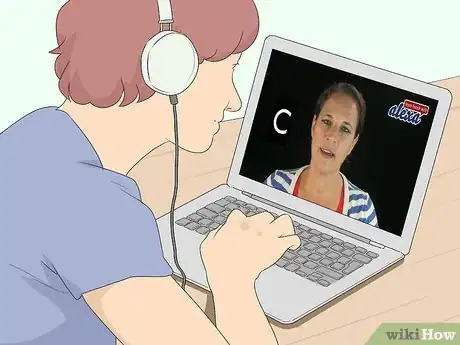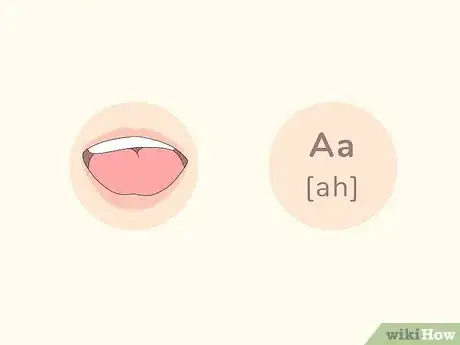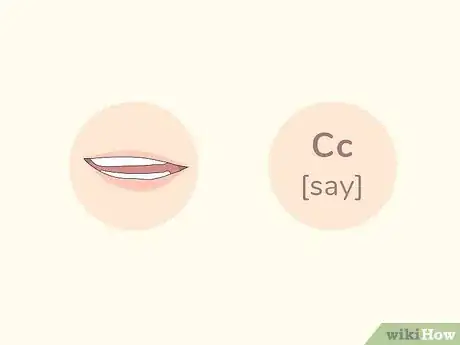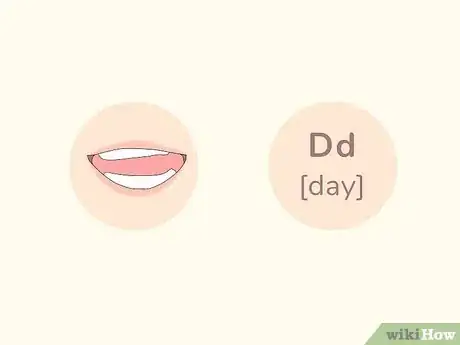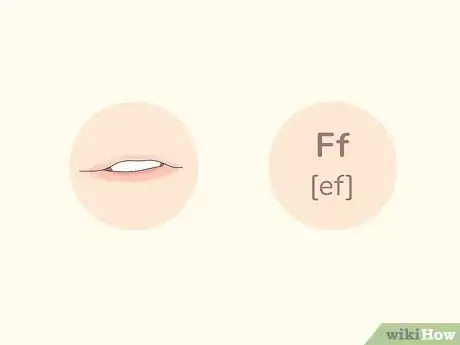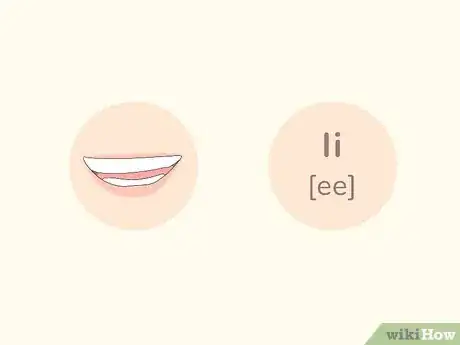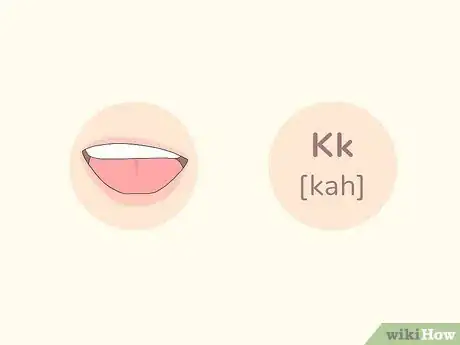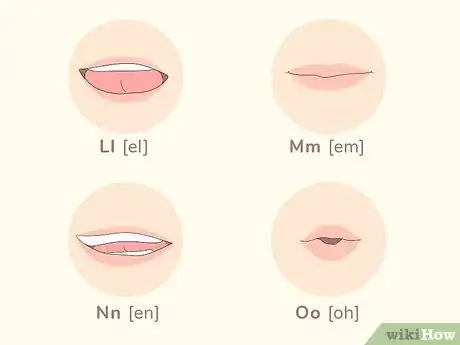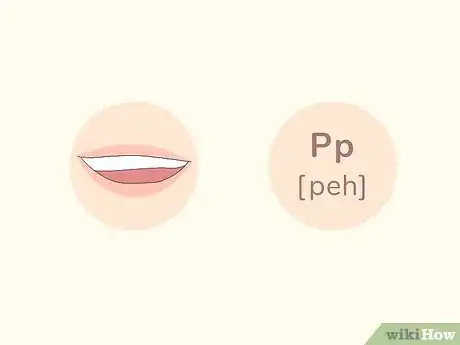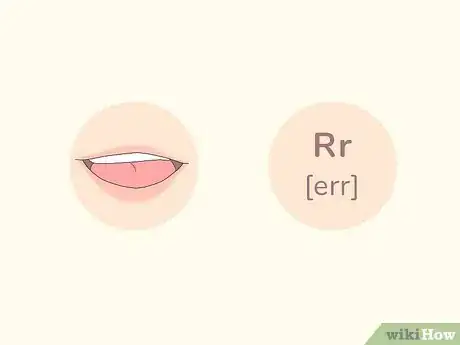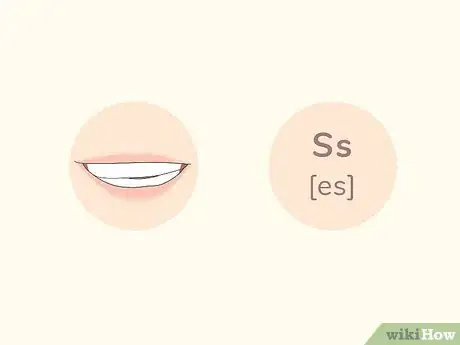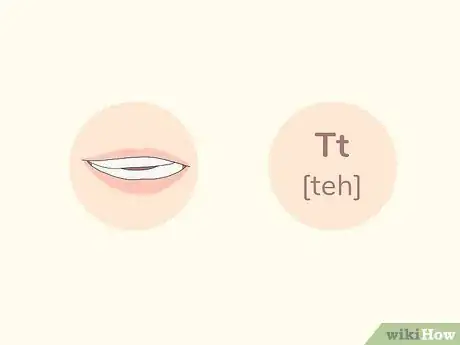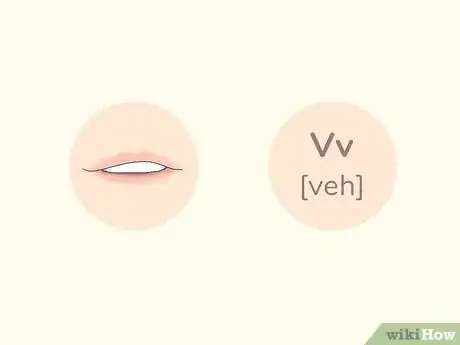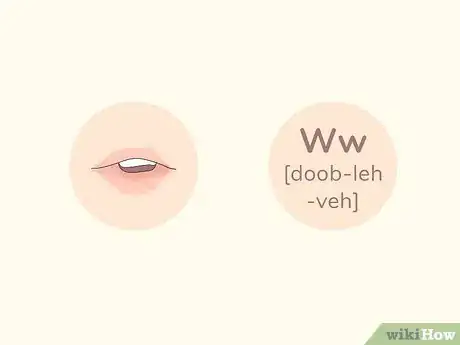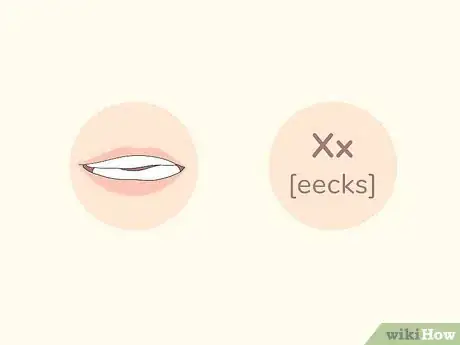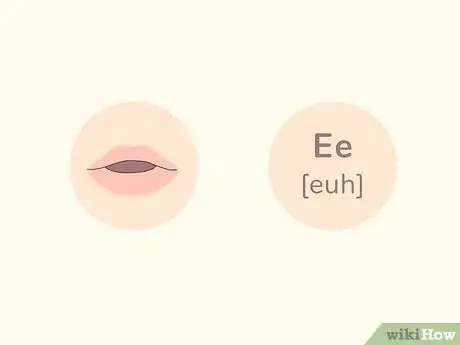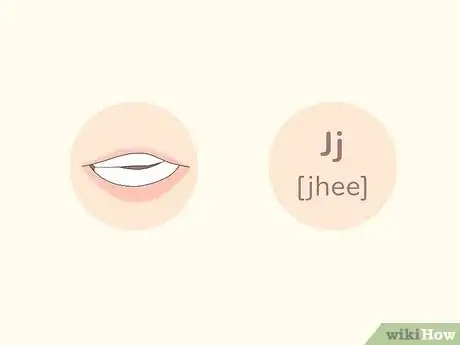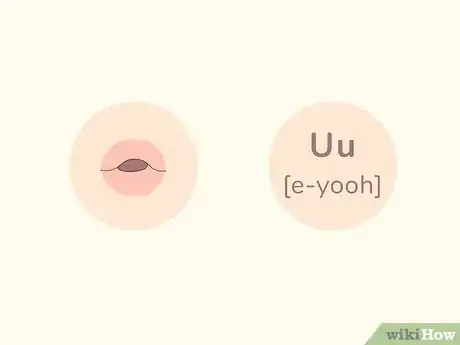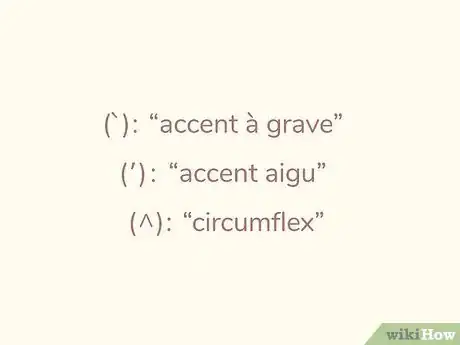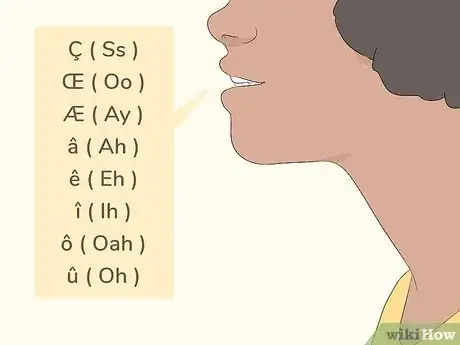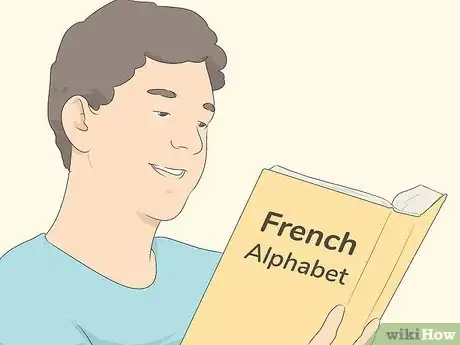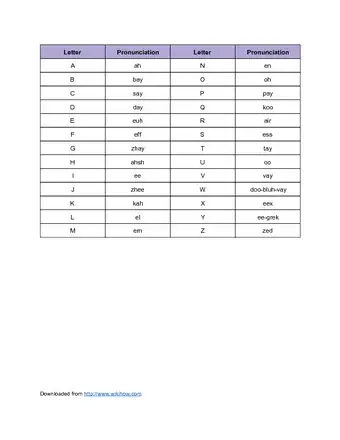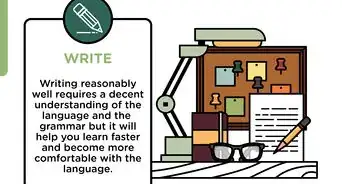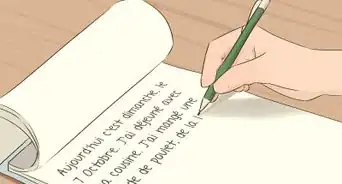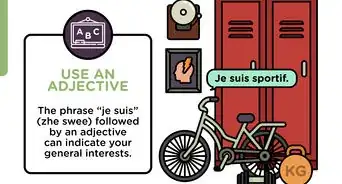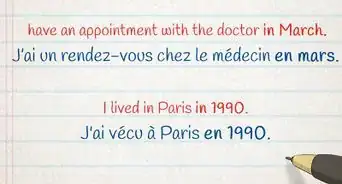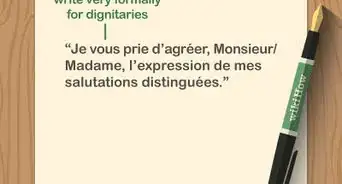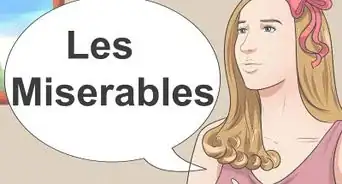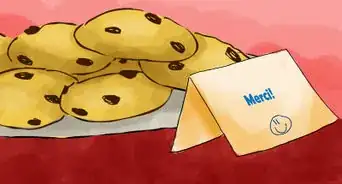This article was co-authored by Lorenzo Garriga. Lorenzo is a native French speaker and French language connoisseur. He has many years of experience as a translator, writer and reviewer. He is also a composer, pianist, and globe-trotter, who has been travelling the world on a shoestring for almost 30 years with a backpack.
There are 9 references cited in this article, which can be found at the bottom of the page.
wikiHow marks an article as reader-approved once it receives enough positive feedback. This article has 21 testimonials from our readers, earning it our reader-approved status.
This article has been viewed 597,705 times.
The French alphabet is the same one used in English, and is also known as the Roman Alphabet.[1] However, the pronunciations are almost all different. Learning them is essential to pronounce French words and to learn how to spell in French. In addition to the normal alphabet, there are several additional accents and combinations that you can learn to increase your fluency.
Steps
Pronouncing the Basic Sounds
-
1Listen to the alphabet pronounced by a native speaker. You can use YouTube to find many examples of people saying the alphabet, and hearing it is often better than trying to read it. Search online to hear each letter as it is pronounced.[2]
-
2Pronounce A like "Ah." Open your mouth wide to pronounce the first letter. This is similar to a "soft A" in English.[3]Advertisement
-
3Pronounce B like "Bey" or "Bay." This is a soft sound, like saying "Hey" in English. Think of the first syllable in the word "baby."[4]
-
4Pronounce C like "seh." The is the first letter that varies strongly from the English equivalent. You can also soften the "ay" sound to be more like an "e," pronouncing it "Cey," like the first sound in the word "saving."[5]
-
5Pronounce D like "deh." Similar to B, C and, later on, V and T. All of these letters use the soft "eh" sound preceded by the letter in question.
-
6Pronounce F like "ef," exactly how it is pronounced in English. The same sound is used in French as English. L, M, N, O, and S are also pronounced like their English counterparts.[6]
-
7Pronounce H like "ahsh." The beginning is a soft A sound, like "ahhhh," followed by the "sh." It is similar to the sound of the slang word "gosh."[7]
-
8Pronounce I like "ee," using a long E sound in English. I is pronounced like the E in "see" or "be."
-
9Pronounce K like "kah." This is another easy one.[8]
-
10Pronounce L, M, N, and O like their American counterparts. These are simple and easy. They sound just like the English version &rarr: "el," "em," "en," and "oh."[9]
-
11Pronounce P like "peh." It is as simple as the English word for making some money.
-
12Pronounce R like "err," but with a slightly rolled R. If you can't roll your Rs, that is okay. A simple "err" will suffice. It is similar to the first syllable of the English word "error."[10]
-
13Pronounce S like "es," similar to English. The S is the same sound in both languages.[11]
-
14Pronounce T like "teh." A simple pronunciation, similar to B and D. Rhymes with "say."[12]
-
15Pronounce V like "veh." Again, this is a simple pronunciation. Rhymes with "day."[13]
-
16Pronounce W like "doob-leh-veh." This translates literally to "double V." Just like in English, W is essentially pronounced like 2 separate words -- "Doob-leh" and "veh."[14]
- The word "double," in French, sounds a bit like "dooblay."
-
17Pronounce X like "eecks." Another way to think about it is "eex." X is not a very common French letter, and sounds more an English X, just with a long E sound before the letter.[15]
-
18Pronounce Z like "zed." Simple and easy, this is actually how many British people pronounce Z in English.[16]
Mastering the Difficult Sounds
-
1Pronounce E like "euh.' This is a very guttural sound, almost like you think something is gross or disgusting. Think of the vowel sign in the word "took," as in, "she took my example."[17]
-
2Pronounce G like "jeh," with a soft G sound. Think of it as saying "jeh," but elongating the j slightly so that is sounds more like an "sh" sound. Think of the G sounds in "George."[18]
- The pronunciation rhymes with the English name "Shea."
-
3Pronounce J like "jhee." This is just like the pronunciation of G, but with an E sound instead of an A.[19]
-
4Pronounce U like "e-yooh," and know that this is probably the hardest letter to pronounce. A good trick for saying U is to start saying a hard E sound, like "eeee," then move move your lips forward as if you were saying "You." This somewhat "compound" sound is tricky, and easiest to learn by listening to native speakers. It is very similar to an exaggerated sound of disgust in English, "ewwwww," but it starts with a very pronounced E sound.[20]
- Your tongue and mouth are situated like an "eee" sound.
- Your lips are rounded in an "O" shape.
-
5Pronounce Q like "kyoo" or "cue." It is similar to the English version, but you slightly de-emphasize the y sound in the middle. It is similar to the French pronunciation of U.[21]
-
6Pronounce Y like "ee-greck." The oddest pronunciation in the alphabet, Y has two sounds: "ee-greck." The second part sounds a bit like "gekko" with an R and no O.[22]
- You do not, however, want to pause between "ee" and "greck." Think of it as a two syllable word.
-
7Know how to talk about the various accents. When adding accents to letters, such as when spelling something for someone, you usually add the inflection or mark after the letters. So, for "è" you would say "e, accent à grave," (or, phonetically, "eh, ak-cent ah grav"). The accents are pronounced:
- A right pointing dash (`) is an "accent à grave." Pronounce "ah-grav."
- A left-pointing dash (such as in é), is an "accent aigu." Pronounce "ah-goo."
- A point up (^) is known as a "circumflex." It is pronounced just like it looks.
-
8Learn to pronounce the special characters. French has a few extra letters and combinations, which brings the total to 34 letters. The additional ones are:
- Ç ( Ss ) (Also known as a çedilla, or "sirdiya")
- Π( Oo )
- Æ ( Ay )
- â ( Ah )
- ê ( Eh )
- î ( Ih )
- ô ( Oah )
- û ( Oh ).[23]
-
9Review the pronunciation of the entire alphabet. Once you have them all down. try saying them in order to practice your pronunciation:
Pronunciation Cheat Sheet
Expert Q&A
Did you know you can get expert answers for this article?
Unlock expert answers by supporting wikiHow
-
QuestionHow can I learn to pronounce French words?
 Lorenzo GarrigaLorenzo is a native French speaker and French language connoisseur. He has many years of experience as a translator, writer and reviewer. He is also a composer, pianist, and globe-trotter, who has been travelling the world on a shoestring for almost 30 years with a backpack.
Lorenzo GarrigaLorenzo is a native French speaker and French language connoisseur. He has many years of experience as a translator, writer and reviewer. He is also a composer, pianist, and globe-trotter, who has been travelling the world on a shoestring for almost 30 years with a backpack.
Native French Speaker
-
QuestionWhat is some simple French vocabulary?
 Community AnswerDownload a GCSE French vocab list and aim to learn a page a week. This will provide you with a basic working vocabulary.
Community AnswerDownload a GCSE French vocab list and aim to learn a page a week. This will provide you with a basic working vocabulary. -
QuestionI'm having trouble differentiating between the pronunciations of "E" and "U." They both sound extremely similar to me. Advice?
 Community Answer"E" is pronounced like the "oo" in wood, took, look, etc., kind of like a deeper version of "uh." "U" is pronounced pretty similarly to how it is in English (like the word "you" but with a bit of a stronger hard "E" at the beginning. If you exaggerate it would be "ee-yuu").
Community Answer"E" is pronounced like the "oo" in wood, took, look, etc., kind of like a deeper version of "uh." "U" is pronounced pretty similarly to how it is in English (like the word "you" but with a bit of a stronger hard "E" at the beginning. If you exaggerate it would be "ee-yuu").
Warnings
- Pronunciations may not be perfect. If possible, ask a French person to say the alphabet for you so you can listen to how they pronounce the letters.⧼thumbs_response⧽
- Do not attempt to sound out French words using these letters, as often there will be accents which change the sound, silent letters, and different sounds than how the letter is pronounced in the alphabet.⧼thumbs_response⧽
- You can easily forget the basics. To avoid this, practice practice practice!⧼thumbs_response⧽
Things You'll Need
- CD-ROM for French beginners
- A good teacher can be invaluable
References
- ↑ http://www.omniglot.com/writing/latin.htm
- ↑ https://www.omniglot.com/writing/french.htm
- ↑ https://mylanguages.org/french_alphabet.php
- ↑ https://www.languageguide.org/french/alphabet/
- ↑ https://www.languageguide.org/french/alphabet/
- ↑ https://mylanguages.org/french_alphabet.php
- ↑ https://www.languageguide.org/french/alphabet/
- ↑ https://www.languageguide.org/french/alphabet/
- ↑ https://mylanguages.org/french_alphabet.php
- ↑ https://www.languageguide.org/french/alphabet/
- ↑ https://www.languageguide.org/french/alphabet/
- ↑ https://www.languageguide.org/french/alphabet/
- ↑ https://www.languageguide.org/french/alphabet/
- ↑ https://mylanguages.org/french_alphabet.php
- ↑ https://mylanguages.org/french_alphabet.php
- ↑ https://mylanguages.org/french_alphabet.php
- ↑ https://www.omniglot.com/writing/french.htm
- ↑ https://www.languageguide.org/french/alphabet/
- ↑ https://www.languageguide.org/french/alphabet/
- ↑ https://www.omniglot.com/writing/french.htm
- ↑ https://www.omniglot.com/writing/french.htm
- ↑ https://www.omniglot.com/writing/french.htm
- ↑ http://www.frenchtutorial.com/en/learn-french/pronunciation/alphabet
- ↑ http://www.omniglot.com/writing/french.htm
- ↑ http://grammarist.com/french/french-alphabet-pronunciation/
- http://www.bbc.co.uk/languages/french/guide/alphabet.shtml
- http://french.languagedaily.com/basics/learn-french-alphabet
About This Article
If you want to learn how to pronounce the French alphabet, remember that they pronounce F, L, M, N, O, and S exactly like we do. Aside from the 8 letters they have that we don’t, their alphabet is pronounced as follows: A (ahh), B (bay), C (say), D (day), E (euh), F (f), G (jhay), H (ahsh), I (ee), J (jhee), K (kaa), L (l), M (m), N (n), O (o), P (pay), Q (kyoo), R (err(rolled r)), S (es), T (tay), U (e-yooh), V (vay), W (dooblay-vay), X (ix), Y (ee-greck), Z (zed). Scroll down to learn how to pronounce the other 8 letters.
